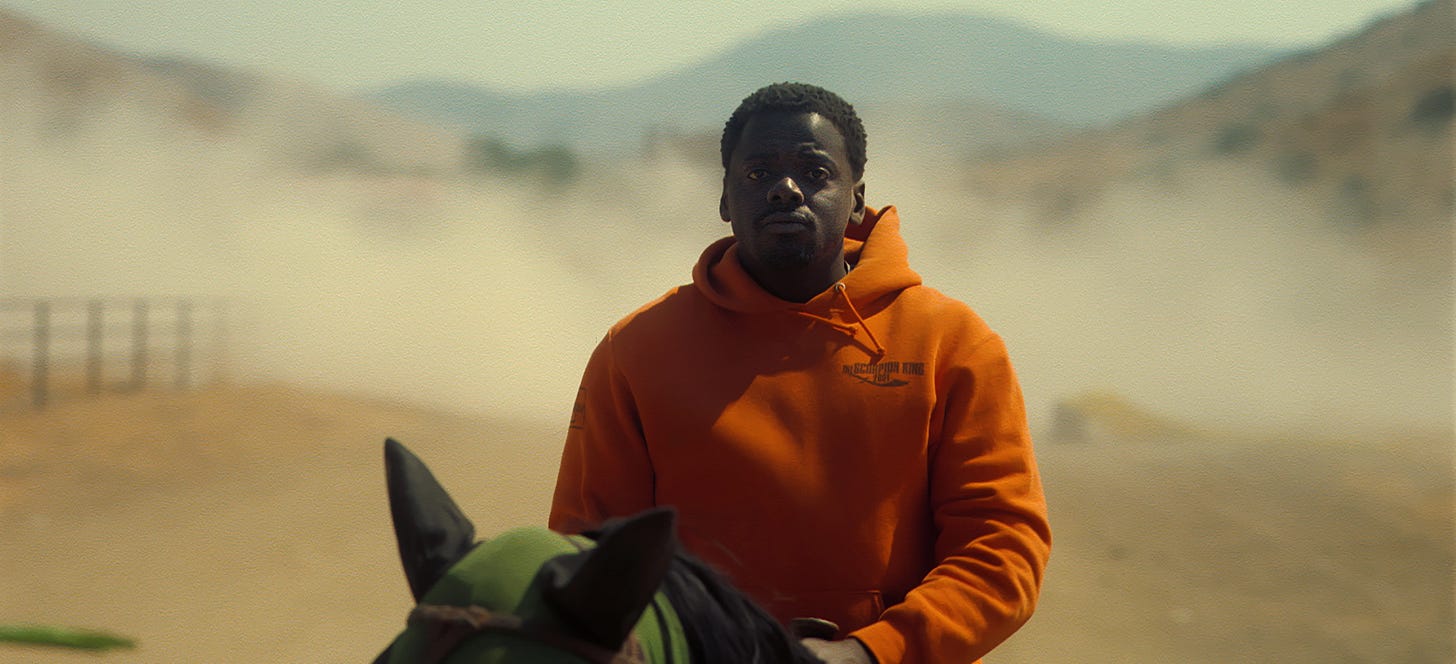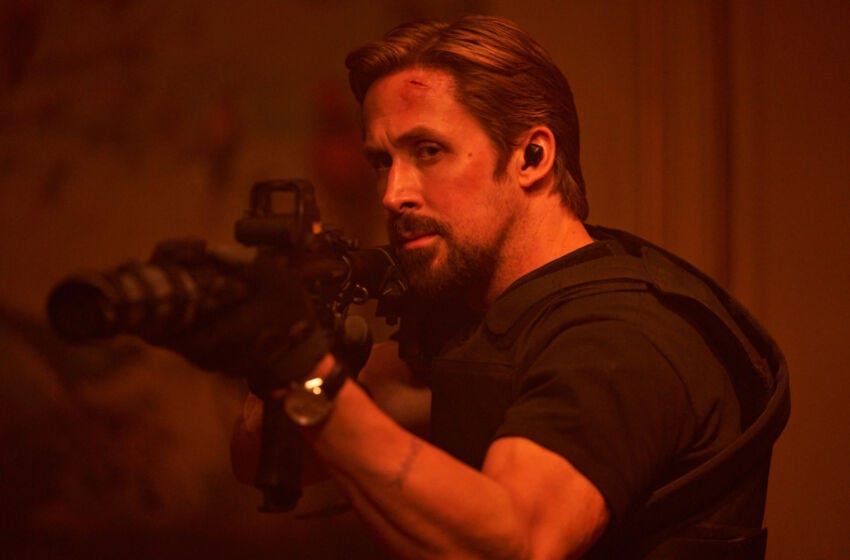In Review: 'Nope,' 'The Gray Man'
Jordan Peele's latest depicts strange doings in the California countryside while the Russos try to launch a franchise without familiar superheroes
Nope
Dir. Jordan Peele
131 min.
Through five seasons of Key & Peele, the sketch comedy show he created with Keegan-Michael Key, Jordan Peele mastered the conceptual hook: The pitch meeting for Gremlins 2, a sophisticate wowed by a hotel’s continental breakfast, valets waxing rhapsodic over the films of Liam Neeson. As Peele has made his way as a film director, he’s capitalized on that gift for the catchy logline, which has helped sell original horror films like Get Out and Us at a time when Hollywood is historically averse to risk. That’s paid off with audiences, who have always tended to pass along good word of mouth about twisty, high-concept horror. It doesn’t take long to explain how much you loved the one about the the Black man terrorized by a visit to his white girlfriend’s house or the one about a family attacked by their own sinister doppelgängers.
But just as a comedy sketch can drift into totally unexpected places—that continental breakfast bit turns into an homage to The Shining—Peele’s features have grown progressively less tidy, developing their own internal logic and circling around themes that weren’t apparent from the opening reels. His beguiling new sci-fi/horror hybrid Nope has the hook of an alien invasion movie along the lines of Close Encounters of the Third Kind or The War of the Worlds—which influence prevails, of course, depends on the visitors’ intentions. Yet it takes off in several unpredictable thematic directions at once, and the elusive messiness makes its ideas feel explored rather than predigested. It’s the alien at the summer multiplex in more ways than one.
The Reveal is a reader-supported newsletter dedicated to bringing you great essays, reviews and conversation about movies (and a little TV). While both free and paid subscriptions are available, please consider a paid subscription to support our long-term sustainability.
Here are some of the major elements that come together for Nope: A Southern California ranch that’s been home to a family of showbiz horse wranglers since the dawn of cinema, a tacky Gold Rush-themed amusement park for families looking for a taste of the Old West, an old sitcom starring a chimpanzee that was abruptly canceled after a gruesome on-set incident. Oh, and also a flying saucer. While the UFO drives the action, Peele leaves it parked in the sky for a while, allowing that enigma to percolate while turning his attention to an eccentric collection of modern cowpokes and Hollywood outsiders.
In a modern twist on the stoic Western hero, Get Out star Daniel Kaluuya plays Otis Haywood Jr. (or OJ for short, a nickname that perplexes strangers), the reluctant inheritor of Haywood Hollywood Horses, a family-run horse-wrangling business since a Haywood appeared as an uncredited jockey in Eadweard Muybridge’s 1878 “The Race Horse,” widely considered the first film ever shot. After his father dies, the reticent OJ struggles to find work in an industry overrun by computer-generated images, and his more outgoing and charismatic sister Emerald (Keke Palmer) is too consumed with her own career to help. Down the road, former child star Ricky “Jupe” Park (Steven Yuen) runs a Western theme park called Jupiter’s Claim, which has bought some Haywood horses and recently built a stage show around strange occurrences in the sky above. One of the strangest: Not far away, there’s a cloud that never moves—except when it does.
To say much more about Nope would be to spoil the slow-burn reveals that writer/director Peele keeps tucked in his back pocket. Within this sprawling conceit, he comments on the marginalization of Black talent and history in Hollywood, our obsession with celebrity, and, most pointedly, how we process human catastrophe as entertainment. Confronting these aliens is one thing, but for these people getting the best possible shot of them on film is paramount, inspiring a wild influx of characters as varied as an electronics store employee and an award-winning cinematographer who prefers to shoot on hand-cranked celluloid cameras. It’s a mad, mad, mad, mad war of the worlds.
Working with the fine cinematographer Hoyte van Hoytema, who has shot most of Christopher Nolan’s recent work along with the sci-fi films Ad Astra and Her, Peele turns the Haywood ranch into a wide-format proscenium of supernatural mayhem. When it’s not clear what and where the forces at work are, the camera darts frantically through the air before gliding to stability, reflecting the terror of facing the unknown. Still, for all of the film’s curious narrative cul-de-sacs, Peele’s abundant talent as an entertainer hasn’t abandoned him, either: The title, which references those times in horror movies when a character should avoid doing something stupid, earns a chuckle every time someone says it out loud. It’s only natural to search for some laughs as the apocalypse looms. — Scott Tobias
The Gray Man
Dirs. Anthony and Joe Russo
129 min.
Sometimes a movie feels more like a cog in a corporate strategy than a story anyone really felt they had to tell. The recent Nicole Sperling New York Times article “Netflix, Still Reeling, Bets Big on ‘Gray Man’” lays out the importance of the Russo brothers’ latest to the streaming service’s plans to become a source not just for blockbuster action films but for blockbuster franchises. To that end, to launch a series of adaptations of Mark Greaney’s espionage novels, Netflix turned to a team collectively responsible for a big chunk of the most successful franchise of this franchise-driven Hollywood era, the Marvel Cinematic Universe, the directors Anthony and Joe Russo and co-writers Christopher Markus and Stephen McFeely. Per the article, this will just be the beginning, assuming all goes well. “The Russos,” Sperling writes, “have plans for expanding the Gray Man universe with additional films and television series, as Disney has done with its Marvel and Star Wars franchises.”
Did all go well? As far as the corporate strategy goes, that will be borne out by the numbers posted by The Gray Man, numbers Netflix will, as customary, keep to itself (though if this proves to be the end of the Gray Man line, it will be easy for the rest of us to draw some conclusions). But as a movie, The Gray Man’s two hours of carefully choreographed action scenes, continent-spanning location shooting, quippy exchanges, and hard drive-straining special effects plays exactly like the backward engineered franchise starter the Times article describes. It’s all spinning parts orbiting around a hollow center.
It doesn’t lack effort, however. You can almost see the note-covered storyboards laying out its many action sequences. Some of them even work. As a collection of set pieces, The Gray Man features all the strengths and weaknesses of the Russos’ Marvel work. It’s gripping and well-executed when it stays close to the ground, particularly when focusing on hand-to-hand combat, but a jumbly mess when it brings in the CGI. An early scene depicting a fall from an airplane could be used by future FX artists as guidance for what not to do.
Everything around those scenes — the plot, the characters, that kind of stuff — is as arbitrary as it gets. Ryan Gosling (appearing in his first film since 2018) stars as Six, a criminal who’s embarked on a second career as a spy since being recruited into the Sierra program by Donald Fitzroy (Billy Bob Thornton) into the strictly-off-the-book black ops Sierra program.
It’s worth pausing here to consider this casting, which suggests a conscious choice to bring in actors who specialize in dry understatement. That’s how Gosling and Thornton play their parts, at least. But whether it’s a case of an artistic decision gone awry or actual disengagement, both look bored no matter how many explosions the Russos throw their way. Or maybe they’re just victims of an underwritten script. That Six really enjoys gum is pretty much his sole defining character trait. Maybe it suggests how much the Russo/Markus/McFeely team has benefitted from being handed a bunch of colorful, larger-than-life characters in their Marvel films. Only Chris Evans as Lloyd Hansen, a sociopathic, Harvard-educated freelance operative who quotes Schopenhauer to his torture victims brings any energy to his role (even when saddled with lines like “You wanna make an omlet, you gotta kill some people.”)
As for the plot: After receiving a McGuffin filled with state secrets, Six has to jet around the world to rescue Fitzroy’s niece (Julia Butters), who has a tension-building heart condition. Maybe that will get fixed in future installments. Stay tuned. —Keith Phipps









One thing me love about Dr. No is how much it not feel like first installment in franchise. It not have familiar well-chreographed opening, it not have iconic theme music, it not have even mild suggetion that James Bond Will Return. Compared to later installments, it feel charmingly low-budget. It only afterwards that someone said, "hey, that was pretty good, maybe we should make another one." And frankly, that pretty good way to do it.
But if you plan on following Marvel blueprint, actually follow Marvel blueprint. Not one laid out by Russos, but one laid out by Stan and Jack. Create bold, colorful characters, and — and this is important bit that seem to always get lost — have something to say about them. Hulk is fun because Hulk Smash, but Hulk is *interesting* because Banner is reluctant hero afraid of what he can do. Spider-Man is fun because he swing through air while tossing off one-liners, but Spidey is *intersting* because under that bravado he insecure teenager who not have any other area of his life together.
If someone actually want to make franchise that work? That have lasting value? That not sputter out after one or two moveis? That how to do it. As with every story, you have to start not with who audience is, or earning potential, or even story or characters. You have to start with what make story interesting.
On surface, Moby Dick is story about whale, but under surface it story about obsession and fruitlessness of revenge. Great Gatsby story about guy who throw big parties, but under surface it about carelessness of idle rich and how no amount of money can change past. Mad Men about guy who work in ad agency, but under surface it story about identities we create for ourselves and lies we tell other people.
That secret of storytelling, and me suspect that under surface of Grey Man is just more surface.
Anyway, Nope look great. It sound like it messier than Peele's other films, but me intrigued by that precisely because Get Out was so precise. If Peele make messy film, it probably not by accident. Me will join him in scoffing at idea that he best horror director of all time, but he certainly one of best directors we have going right now.
I'm sorry this isn't about the movies, or your reviews, but i just want to say how much I LOVE that Gremlins 2 pitch sketch, and thank you for giving me a reason to watch it again.